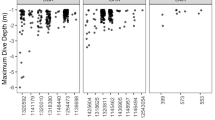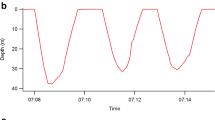Abstract
Core temperature was determined in two king penguins living in the wild at Ile de la Possession, Crozel Archipelago, using implantable four-channel temperature loggers. Core temperatures derived from bird no. 1 (sensor placed under the sternum, in the vicinity of the liver and upper stomach) were closely correlated with diving activity (as determined by an external light recorder), and ranged from 38.3°C, (on land) to a minimum of 37.2°C during a dive. Core temperatures measured in bird no. 2 showed that temperatures near the heart were generally 1°C lower than those under the sternum or in the lower abdomen. Core temperatures declined continuously during dives (by 0.8, 1.2 and 2.7°C in the lower abdomen, under the sternum and near the heart, respectively) and showed precipitous drops to 35°C, probably associated with ingestion of food. Temperatures measured near the heart fluctuated over a period of 288 s, corresponding to the duration (from the literature) of the surface/dive cycle. The relevance of these findings with respect to diving physiology, blood perfusion of tissues, tissue metabolism and aerobic dive limits is discussed.
Similar content being viewed by others
References
Anderson SS, Costa D, Fedak MA (1993) Bioenergetics. In: Laws RM (ed) Antarctic seals. Cambridge University Press, Cambridge, pp 291–315
Aschofi S, Pohl H (1970) Rhythmic variation in energy metabolism. Fed Proc 29:1541–1552
Bannasch R, Wilson RP, Culik BM (1994) Hydrodynamic aspects of design and attachment of a back-mounted device in penguins. J Exp Biol 194:83–97
Barré H, Roussel B (1986) Thermal and metabolic adaptation to first cold-water immersion in juvenile penguins. Am J Physiol 251:R456–R462
Boyd JC, Sladen WJL (1971) Telemetry studies of the internal body temperatures of Adélie and emperor penguins at Cape Crozier, Ross Island, Antarctica. Auk 88:366–380
Castellini MA, Kooyman GA, Ponganis PJ (1992) Metabolic rates of freely diving Weddell seals: correlations with oxygen stores, swim velocity and diving duration. J Exp Biol 165:181–194
Culik BM (1992) Diving heart rates in Adélie penguins (Pygoscelis adeliae). Comp Biochem Physiol A 102:487–490
Culik BM, Wilson RP (1991) Penguins crowded out? Nature 351: 340
Culik BM, Bannasch R, Wilson RP (1994) External devices on penguins: how important is shape? Mar Biol 118:353–357
Culik BM, Pütz K, Wilson RP, Allers D, Lage J, Bost CA, LeMaho Y (1996) Diving energetics in king penguins (Aptenodytes patagonicus). J Exp Biol: 199 (in press)
Davenport J (1992) Animal life at low temperature. Chapman & Hall London
Despin B, Le Maho Y, Schmitt M (1978) Mesures de températures périphériques par thermographie infra-rouge chez le manchot de Humboldt (Spheniscus humboldti). Oiseau Rev Fr Ornithol 48:151–158
Drent RH, Stonehouse B (1971) Thermoregulatory responses of the Peruvian penguin (Spheniscus hutnboldti). Comp Biochem Physiol [A] 40:689–710
Johansen K, Bech C (1983) Heat conservation during cold exposure in birds (vasomotor and respiratory implications). Polar Res 1:259–268
Jouventin P, Capdeville D, Cuenot-Chaillet F, Boiteau C (1994) Exploitation of pelagic resources by a non-flying seabird: satellite tracking of the king penguin throughout the breeding cycle. Mar Ecol Prog Ser 106:11–19
Kooyman GL (1989) Diverse divers. Physiology and behavior. Springer. Berlin Heidelberg New York
Kooyman GL, Kooyman CA (1995) Diving behavior of emperor penguins nurturing chicks at Coulman Island, Antarctica. Condor 97:536–549
Kooyman GL, Kerem DH, Campbell WB, Wright JJ (1973) Pulmonary gas exchange in freely-diving Weddell seals (Lep-tonychotes wedellii). Respir Physiol 17:283–290
Kooyman GL, Wahrenbrock EA, Castellini MA, Davis RW, Sinnett EE (1980) Aerobic and anaerobic metabolism during voluntary diving in Weddell seals: evidence of preferred pathways from blood chemistry and behaviour. J Comp Physiol 138:335–346
Kooyman GL, Cherel Y, Le Maho Y, Croxall JP, Thorson PH, Ridoux V, Kooyman CA (1992a) Diving behavior and energetics during foraging cycles in king penguins. Ecol Monogr 62:143–163
Kooyman GL, Ponganis PJ, Castellini MA, Ponganis EP, Ponganis KV, Thorson PH, Eckert SA, LeMaho Y (1992b) Heart rates and swim speeds of emperor penguins under sea ice. J Exp Biol 165:161–180
LeMaho Y, Delclitte P, Chatonnet J (1976) Thermoregulation in fasting emperor penguins under natural conditions. Am J Physiol 231:913–922
Le Maho Y, Karmann H, Briot D, Handrich Y, Robin J-P, Mioskowski E, Cherel Y, Farni J (1992) Stress in birds due to routine handling and a technique to avoid it. Am J Physiol 263:775–781
Le Maho Y, Gendner J-P, Challet E, Bost CA, Gilles J, Verdon C, Plumeré C, Robin J-P, Handrich Y (1993) Undisturbed breeding penguins as indicators of change in marine resources. Mar Ecol Prog Ser 95:1–6
Millard RW, Johansen K, Milson WK (1973) Radiotelemetry and cardiovascular responses to exercise and diving in penguins. Comp Biochem Physiol 46A:227–240
Mougin JL (1972) Enregistrements continus de températures internes chez quelqueSpheniscidae. I. Le manchot papouPygoscelis papua de l'Ile de la Possession (Archipel Crozet). Oiseau Rev Fr Ornithol 42:85–110
Mougin JL (1974) Enregistrements continus de températures internes chez quelqueSpheniscidae. II. Le manchot royalAptenodytes patagonicus de l'Ile de la Possession (Archipel Crozet). Com Nat Fr Rech Antarct 33:29–56
Ponganis PJ, Kooyman GL, Castellini MA, Ponganis EP, Ponganis KV (1993) Muscle temperature and swim velocity profiles during diving in a Weddell seal (Leptonychotes weddellii). J Exp Biol 183: 341–348
Pütz K (1994) Aspects of the feeding ecology of emperor penguins (Aptenodytes forsteri) and king penguins (Aptenodytes patagonicus) in German. Rep Polar Res 136
Pütz K, Bost C (1994) Feeding behavior of free-ranging king penguins (Aptenodytes patagonicus). Ecology 75:489–497
Schmidt-Nielsen K (1995) Animal physiology. Cambridge University Press, Cambridge
Scholander PF (1940) Experimental investigations on the respiratory function in diving mammals and birds. Hvalradets Skr 22:1–131
Thompson D, Fedak MA (1993) Cardiac responses of grey seals during diving at sea. J Exp Biol 174:139–164
Wilson RP, Culik BM (1991) The cost of a hot meal: facultative specific dynamic action may ensure temperature homeostasis in post-ingestive endotherms. Comp Biochem Physiol [A] 100: 151–154
Wilson RP, Ducamp J-J, Rees WG, Culik BM, Niekamp K (1992a) Estimation of location: global coverage using light intensity. In: Wildlife telemetry. Remote monitoring and tracking of animals. Priede IG, Swift SM (eds) Ellis Horwood, New York, pp 131–134
Wilson RP, Cooper I, Plötz J (1992b) Can we determine when marine endotherms feed? A case study with seabirds. J Exp Biol 167:267–275
Wilson RP, Pütz K, Grémillet D, Culik BM, Kierspel M, Regel J, Bost CA, Lage J (1995) Reliability of stomach temperature changes in determining feeding characteristics in seabirds. J Exp Biol 198:1115–1135
Woakes AJ, Butler PJ, Sevan RM, Boyd IL (1992) The metabolic rate of free-ranging Antarctic animals. Biotelemetry XII: 213–223
Woakes AJ, Butler PJ, Bevan RM (1995) Implantable data logging system for heart rate and body temperature: its application to the estimation of field metabolic rates in Antarctic predators. Med Biol Eng 33:145–151
Author information
Authors and Affiliations
Rights and permissions
About this article
Cite this article
Culik, B.M., Pütz, K., Wilson, R.P. et al. Core temperature variability in diving king penguins (Aptenodytes patagonicus): a preliminary analysis. Polar Biol 16, 371–378 (1996). https://doi.org/10.1007/BF02342186
Received:
Accepted:
Issue Date:
DOI: https://doi.org/10.1007/BF02342186




